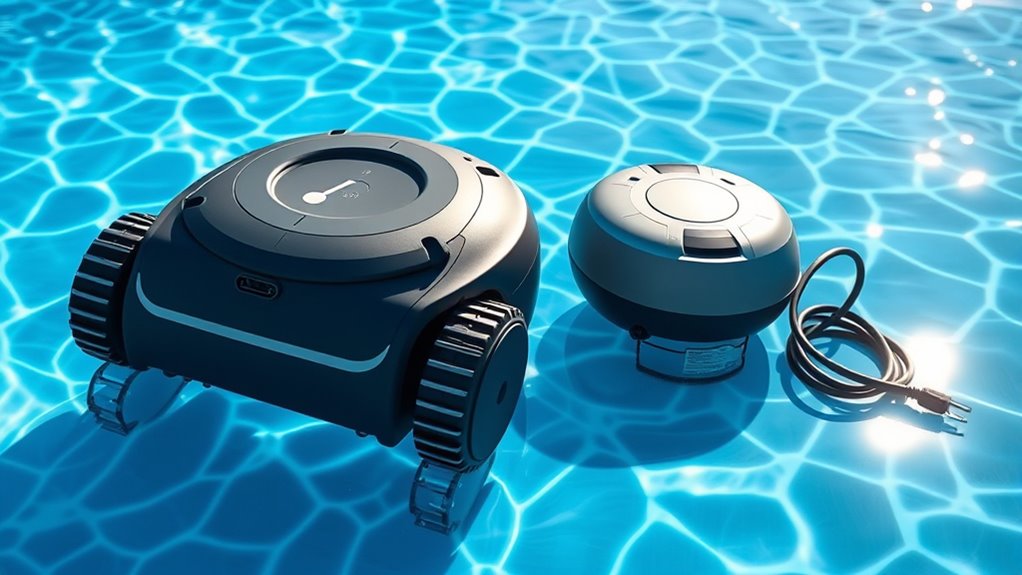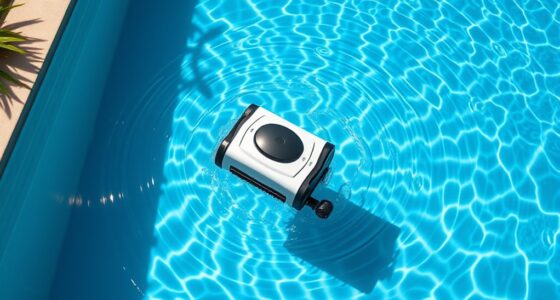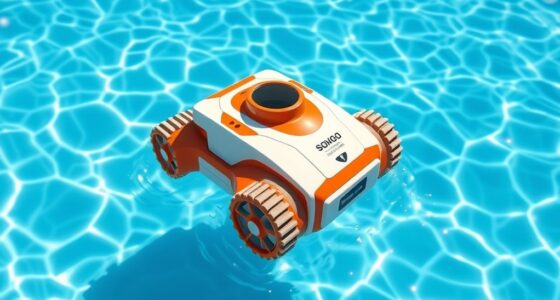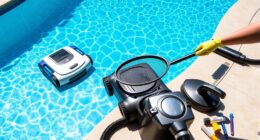Cordless robotic pool cleaners give you greater freedom of movement, easier setup, and compact storage since they don’t need a power cord. They’re ideal for smaller pools or tricky corners, but their battery life can limit cleaning sessions. Corded models offer consistent power, larger coverage, and often are more budget-friendly, though they can be harder to maneuver around obstacles. To find out which option suits your pool best, consider your pool size and your cleaning needs.
Key Takeaways
- Cordless cleaners offer greater mobility, easier setup, and portability, while corded models provide continuous power for larger areas.
- Cordless units typically cost more upfront but reduce tangling issues and storage concerns.
- Corded cleaners depend on a power cord, which can limit movement but ensure consistent, long-lasting power.
- Battery technology advancements in cordless models improve runtime and efficiency, though batteries may require replacement over time.
- Both types deliver effective cleaning, but choice depends on pool size, shape, debris load, and user preference for convenience or continuous power.
Overview of Robotic Pool Cleaners
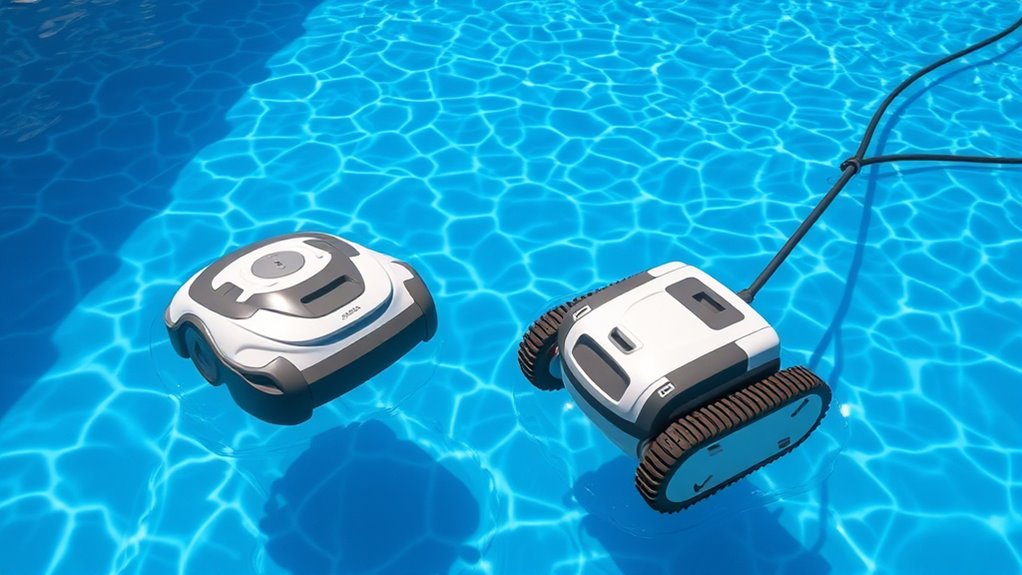
Robotic pool cleaners have become a popular choice for maintaining clean pools because they offer hands-free convenience and efficient cleaning. These devices are designed to move across the pool surface, scrubbing walls and floors to remove dirt, algae, and debris. They typically come equipped with advanced filtration systems that trap fine particles, ensuring the water stays clear. Many models automatically navigate the pool, adjusting their path to cover every inch without your help. The filtration systems are easy to access and clean, making ongoing maintenance simple. Robotic cleaners can be programmed to operate on a schedule, saving you time and effort. Furthermore, the navigation technology used in many models enhances their coverage and efficiency, ensuring no area is missed. Additionally, privacy and data management practices ensure that user information collected during smart features is handled securely and transparently. Modern models also incorporate energy-efficient design, reducing power consumption while maintaining high cleaning performance. With ongoing innovations, some newer models even feature smart connectivity, allowing remote monitoring and control via smartphone apps. Overall, they provide a reliable, automated solution that keeps your pool surface pristine with minimal manual intervention.
Advantages of Cordless Models
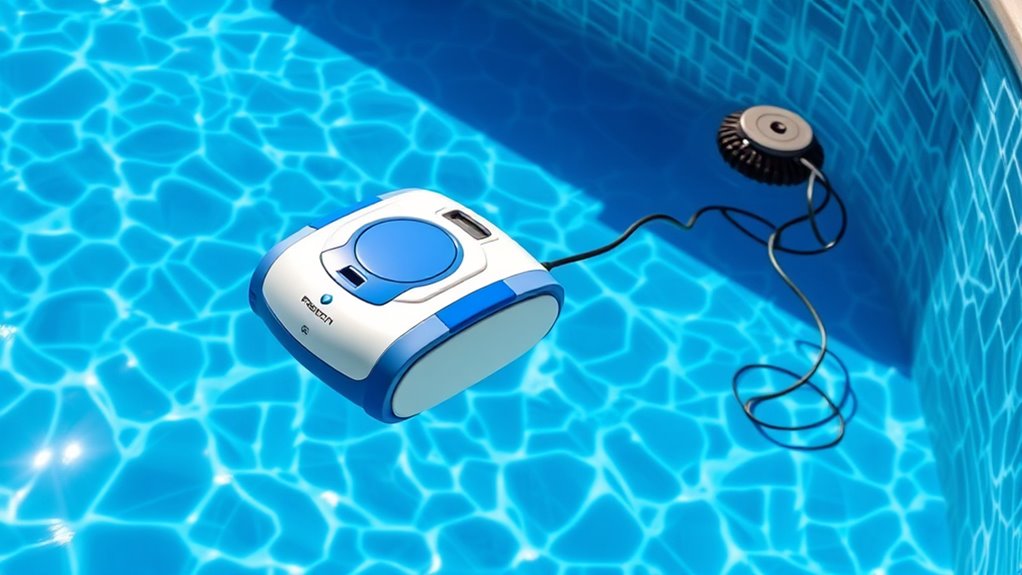
Cordless pool cleaners offer a level of flexibility that wired models can’t match, making them an attractive choice for many pool owners. Without a cord to limit your movement, you can easily navigate around obstacles and reach tricky spots without hassle. Battery longevity is a key advantage; many cordless models now feature powerful batteries that last long enough to clean your entire pool in one session. Plus, without cords, you don’t need to worry about managing or tangling them during operation, which simplifies the cleaning process. This ease of use means you spend less time setting up and more time enjoying a clean pool. Additionally, advancements in AI safety measures are helping manufacturers develop smarter, more reliable cleaning devices that can adapt to various pool conditions. Furthermore, the absence of cords reduces trip hazards, enhancing overall safety during use. Incorporating environmentally friendly batteries is also becoming more common, promoting sustainable pool maintenance practices. As technology continues to evolve, cordless models are increasingly equipped with quick-charging capabilities, allowing for faster turnaround between cleaning sessions.
Benefits of Corded Models
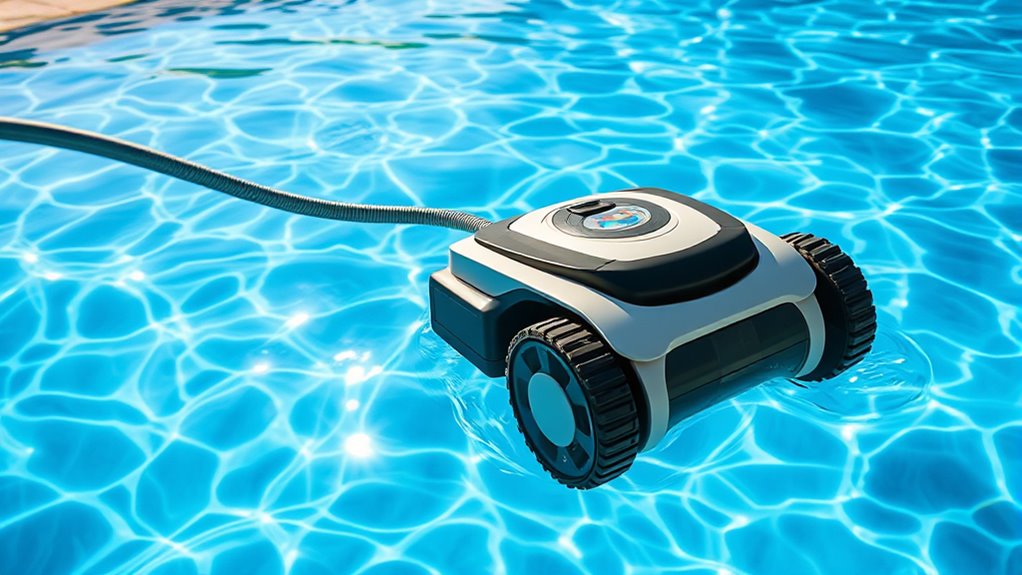
One of the main advantages of corded pool cleaners is their consistent power supply. With a reliable power cord, you don’t have to worry about battery life or recharging. The length of the cord allows you to cover larger pool areas without interruption. A longer cord provides flexibility, reducing the need to reposition the cleaner frequently. Here’s a quick overview:
| Feature | Benefit | Consideration |
|---|---|---|
| Cord Length | Covers larger areas easily | Choose a length suitable for your pool |
| Power Cord | Maintains steady suction power | Ensure it’s durable and tangle-free |
| Connection | Reliable operation | Secure connections prevent interruptions |
This setup ensures continuous cleaning, saving you time and effort. Additionally, proper cable management can help extend the lifespan of your cord and maintain optimal performance, and understanding electrical safety standards can further protect your equipment and ensure safe operation.
Mobility and Ease of Use
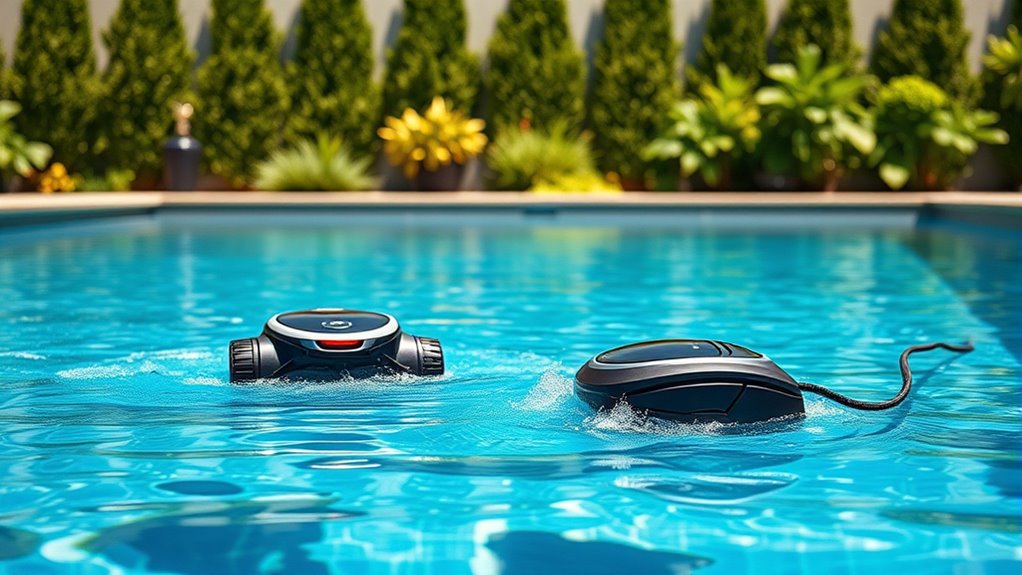
Since corded pool cleaners rely on a power cord, their mobility can be somewhat restricted compared to cordless models. You’ll find that maneuvering around obstacles and reaching tight corners is more challenging with a cord in the way. Cordless cleaners, however, offer greater freedom of movement, making it easier to cover the entire pool surface quickly. Storage options also matter; cordless units are typically more compact and easier to store, saving space when not in use. User safety is another advantage—without a cord running through the water, there’s less risk of tripping or electrical hazards. Additionally, choosing a portable design can enhance convenience and flexibility, allowing you to easily transfer the cleaner between pools or storage areas. The tuning of the motor and control systems in cordless models often results in quieter operation, adding to user comfort. Moreover, cordless models typically feature battery life that can support longer cleaning sessions, reducing the need for frequent recharging. A power management system in advanced models helps optimize battery usage and extend operational time. Overall, cordless models provide a more seamless experience, giving you confidence and convenience while maintaining your pool.
Power and Cleaning Performance
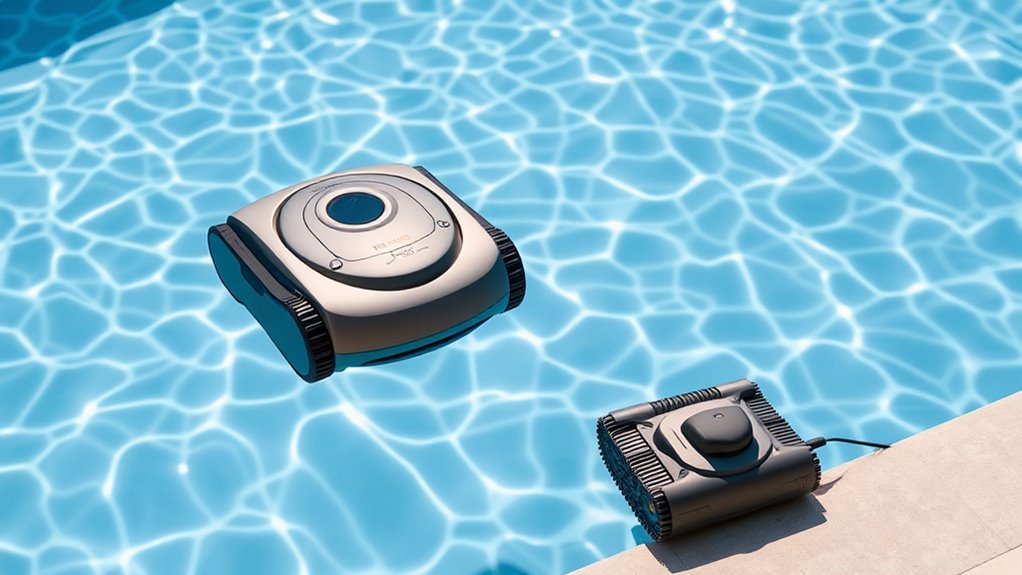
The power source substantially impacts the cleaning performance of pool cleaners, with cordless models often delivering comparable suction and scrubbing capabilities to their corded counterparts. You’ll notice that:
- Cordless cleaners use energy efficiently, reducing power waste during operation.
- They maintain strong suction to lift debris from the pool floor and walls effectively.
- Noise levels tend to be lower, making cleanup less disruptive.
- Cleaning performance remains consistent across both types, provided the models are well-designed.
- Additionally, advancements in battery technology have contributed to the improved energy efficiency of cordless pool cleaners, making them a more viable option for many users.
- The power supply type can influence the overall durability and maintenance needs of the cleaner, which is an important consideration for long-term use.
- Modern cordless models often feature advanced navigation systems that enhance their ability to cover the entire pool surface efficiently.
- The initial cost and long-term maintenance expenses associated with each type can also influence your decision, especially when considering overall cost-effectiveness.
- While corded models may have a slight edge in continuous power, cordless options excel in energy efficiency and quieter operation. Your choice hinges on balancing power needs with preferences for noise and energy consumption.
Battery Life and Charging Considerations
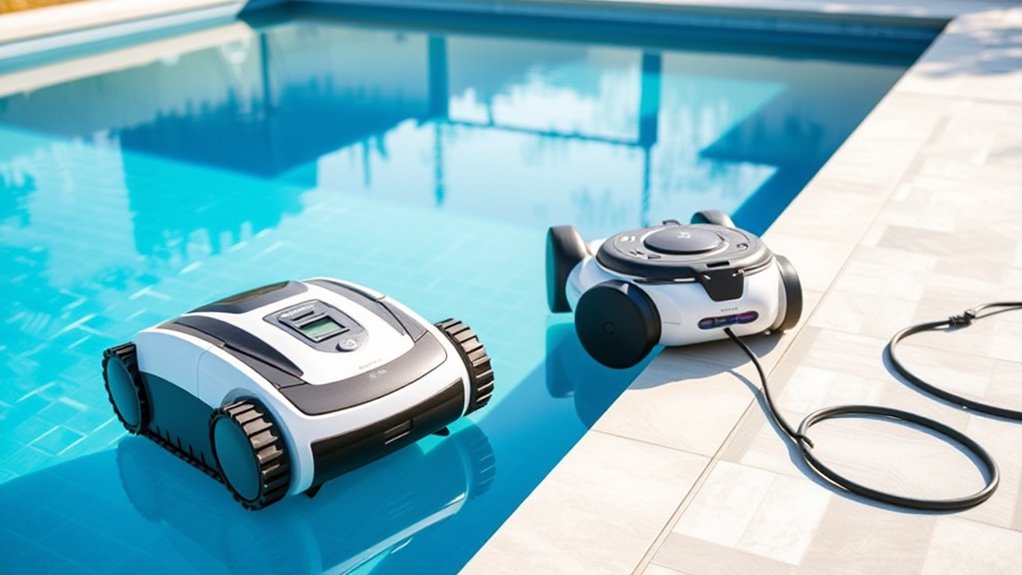
Battery life and charging considerations play a crucial role in choosing between cordless and corded pool cleaners. With cordless models, you’ll want to pay close attention to battery capacity, as it determines how long the cleaner can operate before needing a recharge. A larger battery capacity means more cleaning time, but it may also increase the device’s weight and size. Charging time is equally important; some units take several hours to fully recharge, which can limit your cleaning schedule. Corded cleaners, on the other hand, don’t require charging but depend on a continuous power supply. When selecting a cordless cleaner, consider how quickly it charges and how long its battery lasts to ensure it fits your pool cleaning routine seamlessly. Additionally, understanding battery technology can help you choose a model with longer-lasting and more efficient power sources, especially since improvements in lithium-ion batteries have significantly enhanced overall performance and longevity. Modern advancements in battery management systems can also improve safety and extend battery lifespan. For optimal performance, choosing a high-capacity battery can make a significant difference in reducing charging frequency and extending cleaning sessions. Moreover, evaluating the energy efficiency of the battery system can lead to more cost-effective operation over time.
Installation and Setup Process
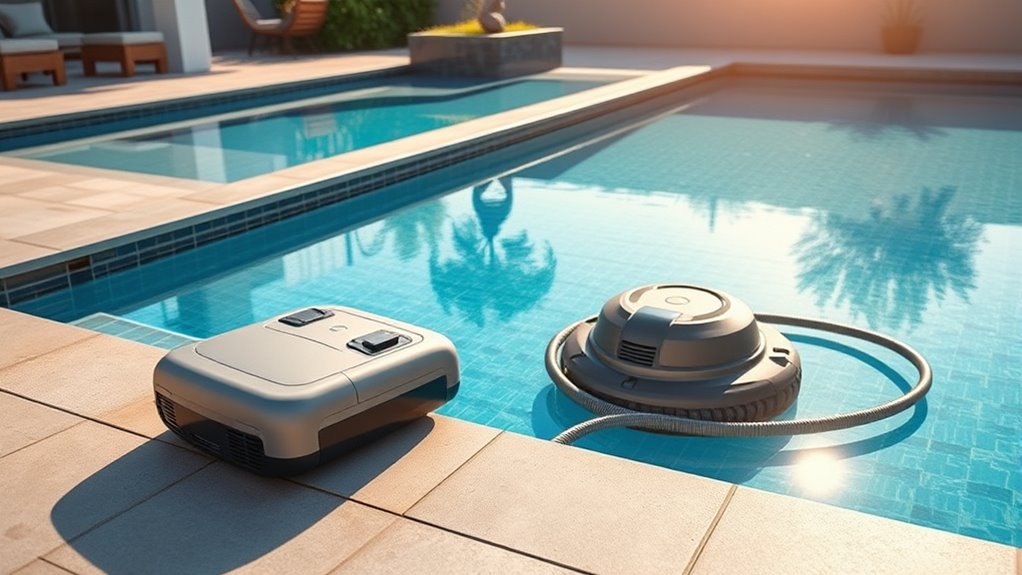
Setting up your pool cleaner is typically straightforward, whether you choose a cordless or corded model. However, some installation challenges can affect setup complexity. To get started, you’ll need to:
Setting up your pool cleaner is usually simple, with minimal challenges depending on the model.
- Unpack the device and verify all parts are included.
- Connect the power supply or charging dock, depending on your model.
- Position the cleaner in the pool, ensuring proper placement for ideal coverage.
- Run a quick test to confirm it operates smoothly.
- Considering industry transformations, selecting a model with advanced features can enhance your cleaning experience. Additionally, ensuring the device has proper waterproofing can prevent potential damage during operation.
Corded models may require you to manage and secure the power cord to avoid tangles, adding to setup time. Cordless units usually have fewer setup steps but might involve initial pairing or app setup. Overall, most setups are simple, but the complexity varies depending on the model.
Cost and Maintenance Factors
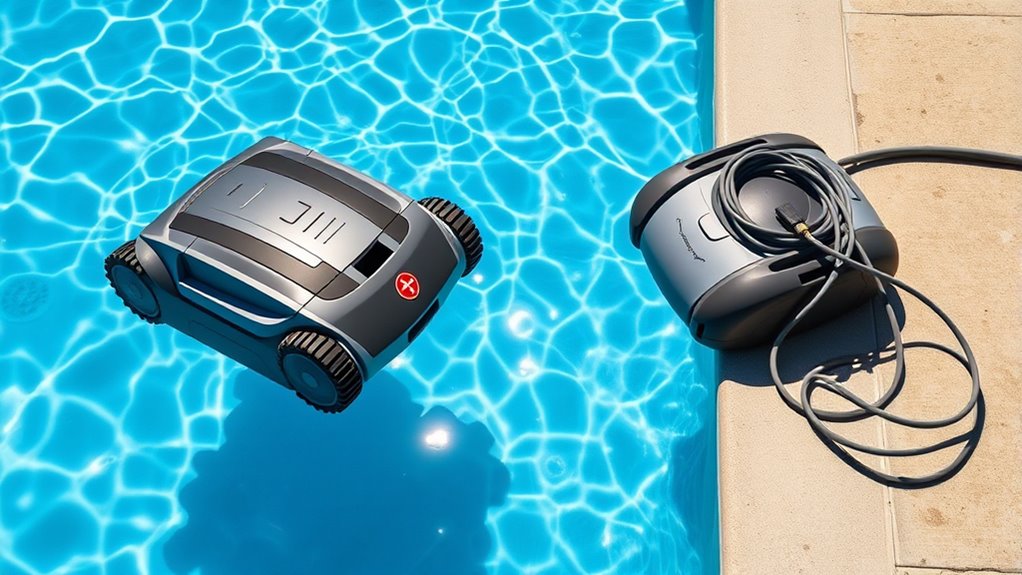
When choosing between cordless and corded pool cleaners, you’ll want to contemplate the initial purchase price and ongoing maintenance costs. Cordless models often have higher upfront prices but may save money on installation and repairs, while corded units typically have lower initial costs but could incur more maintenance. Additionally, think about the battery life versus power supply, as this impacts both long-term expenses and convenience.
Initial Purchase Price
The initial purchase price of pool cleaners varies considerably between cordless and corded models, impacting your overall budget. Cordless cleaners often cost more upfront due to advanced features like larger battery capacity and self-contained power sources. To illustrate:
- Cordless models typically range from $500 to $1,200, depending on battery capacity.
- Corded models usually cost between $300 and $700, with simpler power sources.
- The higher price of cordless units reflects the convenience of portability and longer runtimes.
- Maintenance costs are separate, but initial investment impacts your decision.
While cordless cleaners may seem pricier initially, their advanced battery technology and independent power source offer flexibility. If budget is a concern, corded models are more affordable but less portable.
Ongoing Maintenance Costs
Ongoing maintenance costs for pool cleaners vary considerably between cordless and corded models, affecting your long-term expenses. Cordless units often require additional investments in solar energy-compatible accessories or solar-powered chargers, which can reduce energy costs over time. You’ll also need to monitor and balance your pool chemistry regularly to prevent buildup that could damage the cleaner’s components. Corded models typically have fewer parts that need replacement, but their cords may require periodic inspection for wear and tear. Both types may need occasional cleaning, filter replacements, or minor repairs, but cordless options might incur higher maintenance if batteries degrade or need replacing. Overall, your ongoing costs depend on usage, the quality of the unit, and how well you maintain your pool’s chemistry and energy sources.
Battery vs. Power Supply
Choosing between a battery-powered cordless cleaner and a corded model substantially influences both upfront costs and ongoing maintenance. A cordless model typically has a higher initial price due to the battery and remote control features but offers greater mobility. Meanwhile, a corded cleaner relies on a power supply, which reduces upfront costs but may lead to more wear on the cord and water filtration system over time.
Consider these factors:
- Cordless units require battery replacements, adding to maintenance costs.
- Remote control functionality may need updates or repairs.
- Water filtration systems in both models need regular cleaning, with corded units possibly accumulating more debris.
- Power supply cords can wear out, increasing repair expenses.
Your choice impacts long-term expenses and ease of use.
Choosing the Right Pool Cleaner for Your Needs
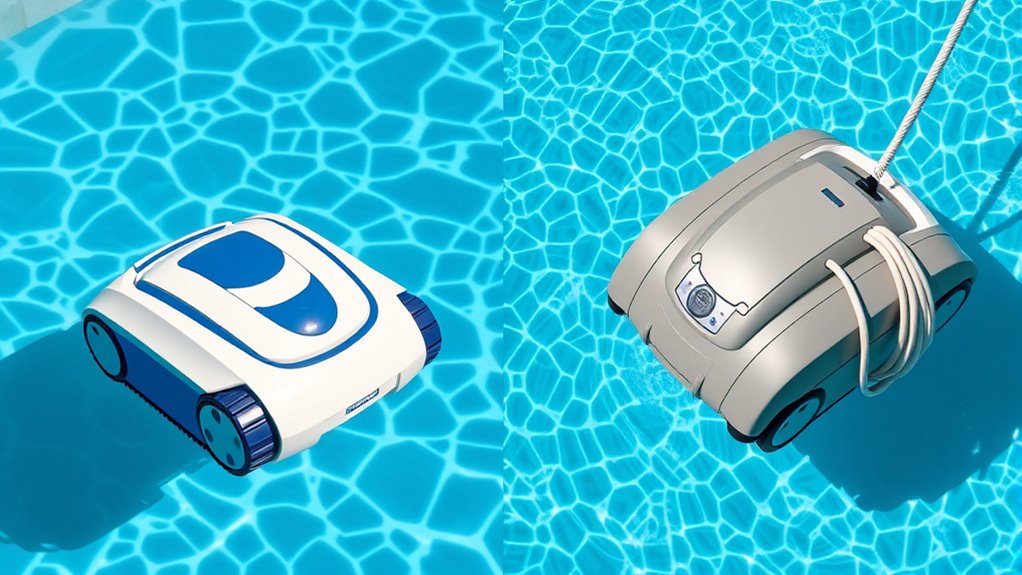
Selecting the right pool cleaner depends on your specific needs and the type of pool you have. If safety is a concern, choose a model with effective water circulation features to maintain water chemistry and reduce hazards. For pools with complex shapes or hard-to-reach areas, a robotic cleaner with adjustable settings offers better coverage. Consider your pool size and debris level; larger or debris-heavy pools may require more powerful suction or longer run times. Think about maintenance, ease of use, and storage space. Both cordless and corded cleaners can be suitable, but your choice should align with your comfort and the pool’s demands. Prioritize models that promote pool safety by protecting water chemistry and ensuring thorough cleaning, making your pool safer and more enjoyable.
Frequently Asked Questions
How Do Weather Conditions Affect Robotic Pool Cleaners’ Performance?
Weather conditions can considerably impact your robotic pool cleaner’s performance. Rain or storms can introduce debris and increase water levels, making pool maintenance more challenging. Extreme heat may cause the device to overheat or work less efficiently. Wind can blow leaves and dirt into your pool, requiring more frequent cleaning. To guarantee ideal performance, you should monitor weather impact and adjust cleaning schedules accordingly, keeping your pool clean and well-maintained.
Are Cordless Models Suitable for Large or Complex Pools?
You’ll find cordless models are generally suitable for smaller pools with simple cleaning needs. For larger or more complex pools, their limited battery life and navigation might struggle to cover the entire area efficiently. If your pool has intricate features or extensive surface area, a corded robotic cleaner with longer runtime and better coverage could be more effective. Consider your pool size and cleaning complexity to choose the best option.
What Safety Features Do Robotic Pool Cleaners Include?
Robotic pool cleaners include essential safety features like safety certifications, which guarantee they meet industry standards, and emergency shutoff systems that stop the device immediately if needed. You should always check for these safety features before purchasing. They help protect you from potential hazards during operation, giving you peace of mind. With safety certifications and emergency shutoff, you can confidently let your cleaner work without worry.
Can Robotic Pool Cleaners Be Used in Saltwater Pools?
You can definitely use robotic pool cleaners in saltwater pools, but check for saltwater compatibility first. Look for models with corrosion resistance, as saltwater can be harsh on equipment. Many modern robotic cleaners are designed with materials that withstand saltwater’s effects, ensuring durability and performance. Make sure to select a cleaner specifically labeled for saltwater pools to avoid damage and enjoy hassle-free cleaning.
How Often Should Robotic Pool Cleaners Be Serviced or Replaced?
You should follow a regular maintenance schedule for your robotic pool cleaner, inspecting it monthly for debris and wear. Typically, you’ll need to replace parts like brushes or filters every 6 to 12 months, depending on usage. Keep an eye on the replacement timeline, and replace your cleaner if it becomes less effective or shows signs of significant damage. Proper maintenance guarantees peak performance and extends its lifespan.
Conclusion
Whether you prefer the freedom of a cordless cleaner gliding effortlessly across your shimmering pool or the steady power of a corded model working tirelessly, the choice is yours. Imagine stepping into crystal-clear water, knowing your cleaner has done its job, leaving behind only sparkling surfaces. Consider your needs, weigh the convenience against performance, and pick the perfect match. With the right cleaner, your pool becomes a inviting oasis, ready for your next swim.
